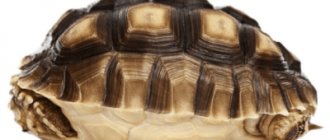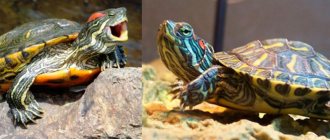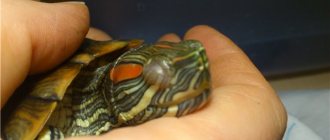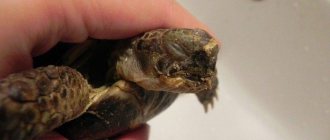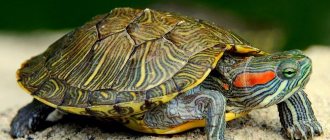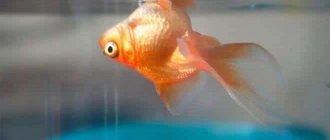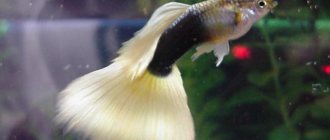The question of why the turtle doesn’t eat arises for most beginners. Almost always, the answer should be sought in improper living conditions, the desire to feed the pet more, as well as simple ignorance of some of the life functions of reptiles.
Diseases
When a red-eared turtle gets sick, it completely loses its appetite. The reptile may suffer from pneumonia, constipation, helminthic infestations, etc. But in addition to refusal to feed, other symptoms are observed in this case.
A herpetologist can determine the reason why the turtle stopped eating. He will select treatment, perhaps prescribe vitamins. In addition, the specialist will tell you how to get the turtle to eat.
If you discover signs of illness in your pet, you should not delay a visit to the veterinarian, otherwise everything may end in the death of your pet.
How to determine if your pet is hibernating
It is quite difficult to distinguish hibernation from death if you do not know certain signs of a living reptile in suspended animation and a dead turtle.
What signs indicate the death of a pet:
- Open mouth.
- Lack of response to light and pain. Shine a light into the reptile's eyes and try to prick its paw with a toothpick.
- Sunken eyes (does not always indicate death).
- Unnatural color of mucous membrane. In living individuals it has a pinkish tint, in dead ones it is gray with a bluish tint.
- Lack of response to heat. Place the reptile in warm water or near a light heat source.
- Rotten corpse smell. The smell appears a couple of days after death. You will most likely notice obvious external signs of decomposition.
If the signs of death are not obvious, for example, sunken eyes, you should contact a specialist at a veterinary clinic, who will determine what is wrong with your pet.
Improper care
The red-eared turtle is a cold-blooded animal; in order for it to be comfortable, the ambient temperature should be from 26 to 35 degrees.
A UV lamp is required to maintain the required temperature. You also need an incandescent lamp with a 40-watt bulb, which must be turned on for 12 hours a day.
When reptiles are cold, they not only refuse food, but also look lethargic, float on the surface and cannot dive. As soon as the ambient temperature is optimal, the animals’ appetite will normalize. If this does not happen, then it is not a case of hypothermia and the help of a veterinarian is required. It must be remembered that overheating is just as dangerous for reptiles as hypothermia.
Causes of loss of appetite
There are many things you should pay attention to to help your turtle feel the joy of life again. Some of the possible reasons that could deprive the mammal of calm:
- Getting used to a new environment;
- Adaptation in captivity;
- Disease;
- Stress;
- Intestinal problems;
- Extreme temperatures (cold or hot);
- Puberty;
- Poor nutrition.
The main reasons for the reluctance to eat are considered to be stress from a change in habitat and hypothermia of the animal. From the transportation process itself, the reptile’s nervous system can be severely damaged and it will take more than one day to recover.
Stress
When you just bought a reptile, it is not surprising that it refuses food. It can take her a day to get used to her new place of residence. The animal is stressed, so she refuses to eat. As soon as the pet gets used to the new conditions, it will begin to take food.
At first, you shouldn’t stand near the terrarium for a long time, much less knock on it. Until the animal gets used to it, you should not try to pick it up, so as not to unnerve your pet again.
Moreover, you should not handle baby turtles; babies are very timid and this can become stressful for them; as a result, they stop eating and may even get sick.
Features of turtle wintering
The first of the reasons we have listed—the dependence of a turtle’s diet on the season—is directly related to its behavior in the wild. Starting in October, turtles begin to eat worse and less often. This is how they react not only to the decreasing day, but also prepare themselves for hibernation. Naturally, they demonstrate the same behavior in captivity, so if the turtle’s refusal to eat coincides with the “Indian summer” period (and there are no signs of illness), most likely your reptile is preparing for sleep. However, herpetologists do not advise encouraging the turtle’s desire for such a long sleep, explaining this by the fact that at home there is only a slight decrease in its activity, during which there is no need for hibernation. Therefore, if a turtle, obeying the dictates of nature, attempts to fall asleep for a long time, you need to increase the temperature of its environment and increase the brightness of the lighting in its aquarium. With such an increase, the turtle will begin to feed on its own in January, when the length of daylight hours increases.
If you missed the moment and the turtle still fell asleep, then you need to move it to a box, put it in a damp and cool place and follow the calendar: by mid-March the reptile should wake up. If this does not happen, be sure to wake it up, otherwise the turtle will die from prolonged dehydration and starvation. You can wake up the turtle by gradually moving its temporary home to a brighter and warmer place.
A turtle that wakes up in the spring, especially one that has spent the winter without moisture and at a relatively high temperature, is characterized by natural anorexia (exhaustion of the body). However, a healthy reptile, no matter how exhausted it may be, will begin to feed approximately a day or two after waking up and turning on the heating. If in the spring it has not started feeding within five weeks and is also in a state of lethargy, you must definitely show it to the veterinarian: long wintering of turtles is associated not only with starvation, but also with dehydration, the consequences of which can be gout and liver or kidney failure.
Improper feeding
Perhaps the red-eared turtle does not eat because it is given the wrong food. She needs animal and plant food. Reptiles should be given lean meat: beef, poultry, horse meat is also suitable. But pork and lamb are contraindicated for turtles, since they are too fatty and the animal’s gastrointestinal tract is not designed to digest them.
In addition to meat, your pet can be given offal. To prevent calcium deficiency in the reptile's body, the diet should include shrimp and low-fat sea fish, which should be given along with bones. You can give raw snails and squid.
But in the absence of plant food, the animal will develop hypovitaminosis and other health problems. You can give dandelion and plantain leaves, carrots, beets, pumpkin, cucumbers, and zucchini.
The older the pet is, the more plant foods should be included in its diet.
But small turtles may refuse if they are given vegetables and fruits; they prefer animal food.
You should not give your pet boiled or fried foods, bread, or dairy products (except cottage cheese).
It is also important to follow the reptile's feeding schedule.
She may be fed too often and given too much food. While the turtle is small, its age is less than 12 months or its size is less than 10 cm, it is fed daily. Adults are given food 2-3 times a week. To determine the volume of one serving, you need to see how much the reptile eats in 30 minutes and give this amount constantly.
Conditions for keeping red-eared turtles
For one animal you need an aquarium with a volume of one hundred to one hundred and fifty liters and land connected to water using a rough ladder. If there is insufficient space, the turtle will not swim or move.
In addition, the following conditions must also be met:
- The surface of the land in the turtle's home should be large enough, sloping, rough and gradually rising. Special islands sold in stores meet all the necessary requirements;
- The water temperature in the aquarium should be higher than room temperature. To heat it, you should purchase a thermostat;
- the air above the island should also be warm, so it is recommended to install an incandescent lamp above it;
- the island should be at a level of thirty centimeters from the edge of the aquarium. If it is located close to the edge, nimble pets can escape;
- The water is cleaned using external aquarium filters. The frequency of water changes depends on their effectiveness. The cleaner the water in the aquarium, the faster the young turtles will grow;
- animals need sunlight, so in the summer they need to be walked with, and in the winter irradiated with ultraviolet light. A UV “Tanning Lamp” is suitable for this; it will need to be used three times a week for four minutes at a distance of thirty to fifty centimeters.
During a walk, the animal should be protected from direct sunlight, walking dogs and crows.
Mating season and other reasons
In captivity, the reptile grows faster and reaches sexual maturity earlier. When the male reaches 10 cm in size, he is ready to mate.
If your pet remains active but ignores food, it may have reached sexual maturity. During the mating season, male turtles are very restless and often have no appetite at all. There is no need to worry; as soon as it passes, the reptile will begin to eat.
Although in captivity the reptile rarely hibernates, with the arrival of autumn the red-eared turtle does not eat, is lethargic and sleeps. In this case, you don’t need to do anything; as soon as January comes, everything will return to normal. It is necessary to maintain the same temperature regime and dose of UV rays; the pet will survive the fall, but will be a little less active.
If, after all, the animal has fallen into hibernation and does not open its eyes, then you need to be prepared that it will sleep for 1-2 months. You need to place your pet in a small house, pour 10 cm of sand on the bottom and pour a little water to maintain humidity. After this, over 1.5 weeks, you need to gradually reduce the ambient temperature to 8-10 degrees. Your pet should be checked regularly during hibernation.
If there are several turtles in the terrarium, then perhaps they take each other’s food. In this case, you need to observe the reptiles and if you notice that one of them does not have enough food, then during feeding it should be removed and given food separately.
Why doesn't the turtle eat anything?
Refusal to eat can be the result of a variety of reasons. Some species are sensitive to temperature changes, others do not eat the food offered, sometimes this is a process of adaptation or behavior patterns at different periods of the year.
- When an exotic pet appears in the house, the process of feeding it is exciting and you want to pamper it with different delicacies. However, the first and most common reason why a turtle does not eat is overfeeding. The young eat little by little every day, and the adult eats enough in just three meals a week. By observing the turtle, you can determine its portions and taste preferences, because you won’t be able to force feed it.
- If there are several individuals in the aquarium, the male turtle does not eat due to the desire to reproduce. Pets simply do not want to waste time and energy on food. After mating, everything will return to normal and the appetite will resume.
- When a turtle does not want to eat and does not open its eyes, it should be taken to a specialist. A common cause of illness is low temperature and improper care. This issue can only be resolved after consultation.
Why don't turtles eat in winter?
With the arrival of autumn cold weather, many species begin to prepare for hibernation. There are several important points in this matter.
- The idea of wintering is to sleep in a cool, damp place before the temperature starts to rise. If there is food left in the stomach, after waking up the death of the turtle is inevitable; at best, it will wake up sick and long-term treatment will begin.
- Therefore, it is difficult to ensure the correct hibernation regime at home. But nature itself suggests giving up food and switching to low energy expenditure. The red-eared turtle does not eat in winter for the same reason: it is gradually preparing for suspended animation.
- To prevent hibernation, you should increase the temperature and install a UV lamp.
Why doesn't the red-eared slider eat anything?
This species is capricious and picky in matters of home maintenance. Long before purchasing, you should learn more about the basic rules of content in order to avoid common mistakes.
- As the temperature in the apartment drops, the red-eared turtle becomes lethargic and does not eat. These are the first signs of preparation for winter sleep. Hibernation over the winter should not be allowed at home. You should increase the temperature in the house and install a lamp.
- If the turtle does not eat, but the activity remains the same, you have acquired a male and he is showing sexual activity. This is typical when keeping several turtles in an aquarium. After the mating season, the red-eared turtle will eat in the same portions.
- It makes sense to observe the situation in an aquarium where several individuals are kept. Sometimes the larger ones begin to dominate and simply take food away from the other cohabitants.
- Red-eared turtles require a constant temperature of about 30°C. This is the main condition for maintaining vital processes, this also applies to the reptile’s appetite.
- We must not forget about the peculiarities of feeding. A young red-eared turtle eats only meat; for adults, half of the diet consists of food of plant origin.
The land turtle does not eat
Inexperienced owners of land turtles often do not fully understand the importance of observing the conditions of keeping the reptiles. The Central Asian species does not claim a lot of attention; the reptiles are truly unpretentious. However, every beginner faces the problem of lack of appetite. If the already listed general answers to the question why the turtle does not eat do not fit the description, the land pet is probably refusing food due to another reason.
- The place of purchase is of great importance. Buying from someone unknown increases the likelihood of bringing home a sick animal significantly. The first thing you should check is the lower part of the shell and the mouth and neck for yellow spots and flakes.
- Delivering a pet home is another challenge for the owner. Refusal to eat at first is a consequence of adaptation. However, on the way home the turtle could have caught a cold. For the same reason, experts strictly do not recommend allowing a turtle to roam freely around the apartment.
- Find out what your pet was fed before the sale. The turtle eats familiar food more readily in new conditions.
Why doesn't the turtle eat food?
When it comes to feeding, any extreme can cause irreparable harm to the pet’s health. Therefore, a combination of dry store-bought food and natural food is considered the optimal solution. If your turtle doesn't eat a certain food, this may be a sign that it needs to change its diet.
- Every pet has its own taste preferences. It is likely that you did not like the proposed brand of food. Sometimes the composition causes constipation or indigestion, causing the turtle to ignore the pellets and not eat.
- If you offer only natural food, the body will spend more energy on digestion, but will receive fewer minerals and vitamins. A diet of only dry food will compensate for the lack of microelements, but will worsen digestion. You will have to use trial and error to find out why the turtle is not willing to eat, but rely on the promises of the manufacturers. The breeder’s task is to find the optimal ratio of natural and granulated food.
The turtle does not open its eyes and does not eat
After the winter period, the pet should return to activity and its previous appetite. If this does not happen on the fifth or sixth day, you should consult a specialist. An alarm signal is the turtle's constantly closed eyes.
- An obvious reason why a turtle is not eating may be a lack of vitamin D. A UV lamp will help replenish its deficiency. Closed eyes, lethargy and refusal to eat are the first symptoms of rickets or metabolic disorders. The turtle should take sunbathing under a lamp for about 12 hours a day; in addition, vitamins and medications must be introduced into the diet to restore the body after wintering.
- The picture when a turtle does not eat anything, and its eyes are closed and signs of conjunctivitis are already visible, is characteristic of a lack of vitamin A. The fact is that vision in reptiles plays a vital role for nutrition, therefore inflammation of the eyelids will certainly lead to a refusal to eat. Washing, injections and other procedures will be prescribed by a specialist; in this case, self-medication poses a real threat to the life of the turtle.
The turtle does not eat and constantly sleeps
Wintering in apartment conditions without hibernation presupposes a low-active lifestyle, but this period is confined to a very specific time frame. Large adult individuals hibernate for 12-14 weeks, young animals for 8-10. If on the fifth day after the supposed end of hibernation the turtle does not begin to return to its previous rhythm, this is a sign of disturbances in the body.
- The appetite will return gradually; there is no point in expecting sudden active eating of your favorite food. Spring anorexia, when about 40% of weight is lost during the winter without food, is considered normal. Warming up under a lamp will return your pet to an active life.
- The obvious reason why a turtle does not eat and sleeps constantly may be dehydration and exhaustion of the body. If before the hibernation period the animal did not have time to empty its stomach, there is a possibility of kidney or liver failure due to improper wintering.
The turtle does not eat and does not swim
Proper living conditions are relatively easy to maintain; this is the key to the health and life of your pet. Letting it walk on the floor or carpet, not checking the temperature of the water and air, forgetting about the gradual decrease or increase in temperature with the change of season - all this is a direct path to the development of pneumonia in a turtle. If an aquatic turtle does not eat and immediately falls over on its side in the water, these are symptoms of pneumonia. Injections, warming under a lamp, increasing the temperature and warm steam baths will help here. All this is prescribed by a specialist.
Little turtle doesn't eat anything
For young animals, typical reasons for refusing food are adaptation after a change in living conditions and improper care. To avoid health problems when your baby turtle doesn't eat, you should follow the advice of experienced breeders.
- Purchase a reptile only from a trusted pet store.
- Deliver it home as quickly as possible, and try not to catch a cold.
- Provide the home with all the necessary living conditions and give it a week to adapt. Only after five to seven days can food be offered.
Solution
When owners notice that their pet refuses to eat, they have a question about how to force the red-eared turtle to eat. First you need to create optimal conditions for the reptile, be attentive to the animal, offer it various types of food. You need to feed your pet at the same time so that he gets used to it and waits for this hour. If a turtle has symptoms of a disease, it should be shown to a specialist as quickly as possible; you should not treat it yourself, since only a veterinarian can make the correct diagnosis and prescribe adequate therapy.
How to extend the life of a turtle
To prolong the life of a red-eared turtle, it is enough to protect it from diseases and unfavorable conditions. A properly sized terrarium, balanced food, a heating lamp, quarantine for new individuals and timely inspections at least once a month - all this does not require much time, but can serve well.
A pet whose care is given enough attention may well become a long-liver and become familiar to several generations of the same family. To do this, you should get a young individual, for the purchase of which you need to equip a spacious terrarium.
Mating games
Finally, another natural reason for the red-eared turtle to change its behavior when it stops eating is the onset of mating season, but if the reptile is kept alone or has not reached the age of sexual maturity, this option is unlikely. If a male and a female red-eared turtle are kept together in the same aquarium and have reached the ages of 5 and 4 years, respectively, then you are unlikely to be able to prevent them from conducting mating games, and you just need to wait until they start eating again as before. . During this period, red-eared turtles become aggressive and refuse to eat.
Pneumonia
The most unpleasant explanation for the low activity of the turtle is the possible illness of the pet. Often it is malaise that leads to the fact that the turtle eats little and sleeps a lot. The most common disease in house-kept red-eared turtles is pneumonia. When pneumonia occurs, the reptile becomes lethargic, inactive, stops eating food, and begins to float to the surface of the aquarium with its mouth open. The cause of pneumonia in a turtle may be hypothermia, which occurs due to a prolonged lack of heating in the terrarium, as well as a long stay in a draft. If a red-eared turtle gets pneumonia, it will collapse on the affected lung when swimming. At the same time, the reptile will breathe through its mouth and dive into the water less often, as it will experience difficulty breathing.
Hibernation
The hibernation that red-eared turtles go into in winter is another reason why the pet suddenly stops eating and does not show itself from behind its shell. Do not underestimate the risks of this condition for the red-eared slider, since at home it is very difficult to create an authentic environment in which the reptiles wait out the winter. Therefore, if you suspect that your tortoise is about to hibernate, take steps to prevent it from falling asleep, otherwise there is a chance that your pet will not wake up from its sleep state in the spring. To do this, increase the temperature in the terrarium to 28˚C, increase the level of illumination there, extending the period of daylight by two to three hours.
If you still missed the moment when the red-eared turtle hibernated, provide it with conditions for comfortable waiting out the cold season. Place it in a wooden box and place it in a place with high humidity and low temperature. The red-eared slider should begin to emerge from hibernation around mid-March. If the red-eared turtle still does not wake up, the owner of the animal should begin to take measures to awaken it, otherwise the pet will die from exhaustion and dehydration. To do this, you need to gradually increase the level of illumination and temperature of the box with the turtle every day.
